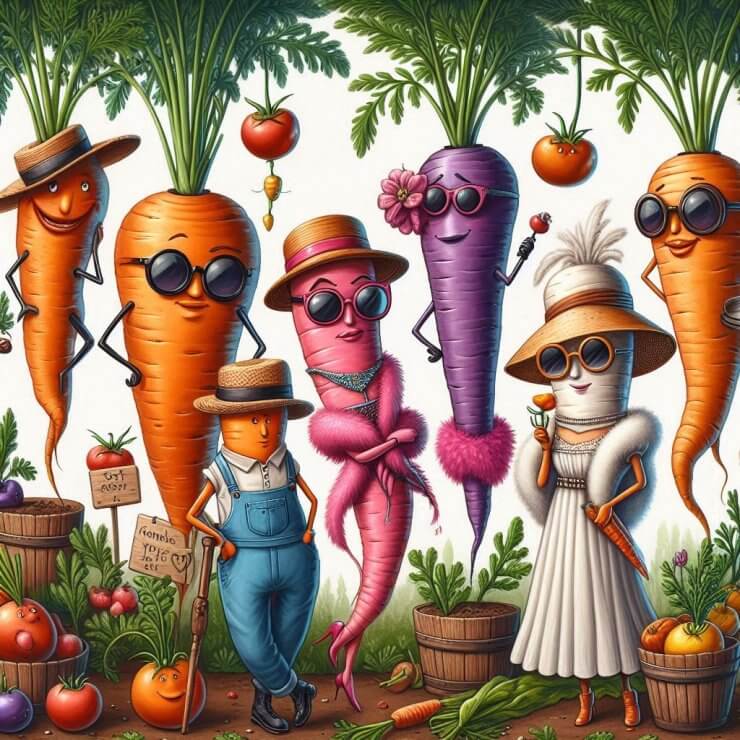Read by Michael Flamel

Once upon a time, before carrots gained their iconic orange hue, they were wild things—bitter, pale, and purple. Some say they were so earthy-tasting that even rabbits rolled their eyes. But like all good things, the humble carrot’s story is one of transformation, migration, and, yes, even rebellion.
The carrot’s origin story begins in the ancient lands of Persia, around modern-day Iran and Afghanistan. Early varieties weren’t orange but purple, white, and yellow. Ancient farmers soon discovered that carrots could be sweetened through careful cultivation. But it wasn’t until Dutch growers, in a fit of patriotism during the 17th century, bred the orange variety in honor of their beloved House of Orange, that the world embraced the carrot’s vibrant makeover.
And just like that, carrots went global. They hitched rides on merchant ships and camel caravans, eventually appearing in European stews, Indian curries, and Chinese stir-fries. Everywhere carrots arrived, they adapted, changing colors, shapes, and sizes to suit local tastes and climates.
Carrot Couture: Grocery Store vs. Farmers Market Varieties
Your typical grocery store carrot is a sleek, orange spear called the Imperator. Long, sweet, and crunchy, the Imperator is the supermodel of carrots. It’s bred to fit perfectly in plastic bags and is the poster child of healthy snacks.
However, wander through a farmers market or tend your own garden, and you’ll discover the eccentric cousins of the grocery store carrot.
Danvers: A plump, stocky carrot, perfect for soups and stews. These are workhorses—perfect for those who prefer chunky roots that won’t disappear in a pot.
Chantenay: Short and stout, Chantenays can thrive in heavy soil where longer carrots might struggle. They’ll make you look like a gardening genius even if you tend to forget watering.
Purple Cosmic and Dragon: A kaleidoscope of purples with bright orange cores, these carrots scream, “I’m here for flavor and flair.” They make for stunning salads and bewildered dinner guests.
Parisian Globe: These are the golf balls of the carrot world—round, crunchy, and unapologetically cute. Perfect for kids or for gardeners with poor soil.
Home gardeners tend to choose varieties for more than just looks—they need to consider soil type, length of growing season, and, of course, bragging rights.
Growing Carrots: “Patience is a Virtue, or So They Say”
Carrots aren’t prima donnas, but they do have standards. They prefer sandy, well-drained soil, full sun, and—this is crucial—space to stretch their roots. If they encounter rocks or compacted dirt, they’ll retaliate by growing crooked or forked, resulting in carrots that look like they belong in a modern art exhibit.
Carrots thrive in USDA hardiness zones 3-10. Depending on your zone, carrots can be sown in early Spring or late Summer. In cool climates, a gardener might plant a Spring crop and again in late Summer for a Fall harvest. Southern gardeners might sow seeds in Winter to avoid the scorching Summer heat that carrots hate.
Carrots and Their Slow-Motion Drama
Carrots teach us the art of patience. You won’t get immediate gratification here. Seeds can take two to three weeks to sprout, just long enough for most gardeners to start worrying they’ve done something wrong. But the carrot knows what it’s doing. With steady watering and care, it will reward you with an abundant harvest—just not until it’s good and ready.
The secret to knowing when to harvest? Give the top a tug and see if you can glimpse the shoulder peeking through the soil. If it’s about the size you were hoping for, go ahead and pull. If not, whisper a word of encouragement and give it a little more time.
Carrot harvesting can also turn competitive. You’ll see gardeners comparing the straightness and length of their carrots like fishermen telling stories about the one that got away. Meanwhile, homegrown carrots—gnarled or straight, long or short—are far sweeter than their grocery-store cousins. Some say they taste like sunshine, dirt, and victory.
A Carrot for Every Occasion
Whether you’re munching baby carrots dipped in hummus, stirring shredded carrots into morning muffins, or roasting rainbow carrots with rosemary, there’s no shortage of ways to enjoy them. They’re versatile enough to be both humble and elegant. A carrot soup can warm you on a cold day, while a carrot soufflé could earn you a standing ovation at a dinner party.
And don’t forget the carrot’s role in dessert: Carrot cake, anyone? With its warm spices and cream-cheese frosting, it’s a sweet reminder that vegetables can indeed lead double lives.
A Carrot-y Conclusion
The carrot may seem simple, but it’s anything but. From its roots in ancient Persia to its star turn in Dutch history, the carrot has traveled far and evolved into many forms. Whether it’s gracing a dinner plate, starring in a school lunchbox, or waiting patiently underground to be unearthed, the carrot is a champion of versatility.
And while carrots don’t ask for much—just a little dirt, some water, and patience—they give so much in return. So, next time you pull a carrot from the ground or grab a bunch at the store, take a moment to appreciate its colorful past, its crunchy present, and the delicious possibilities it holds.
And if you’re thinking about creating your own carrot patch, check out our complete guide to growing carrots in your own backyard for some great tips on selecting varieties, planting and growing, and some delicious recipes. ❖


 Previous
Previous

